
Symphyotrichum novae-angliae is a species of flowering plant in the aster family (Asteraceae) native to central and eastern North America. Commonly known as New England aster, hairy Michaelmas-daisy, or Michaelmas daisy, it is a perennial, herbaceous plant usually between 30 and 120 centimeters tall and 60 to 90 cm wide.

Sanguinaria canadensis, bloodroot, is a perennial, herbaceous flowering plant native to eastern North America. It is the only species in the genus Sanguinaria, included in the poppy family Papaveraceae, and is most closely related to Eomecon of eastern Asia.

Persicaria pensylvanica is a species of flowering plant in the buckwheat family, Polygonaceae. It is native to parts of North America, where it is widespread in Canada and the United States. It has also been noted as an introduced species in parts of Europe and South America. Common names include Pennsylvania smartweed and pinkweed.

Uvularia is a genus of flowering plants in the family Colchicaceae, which is closely related to the lily family (Liliaceae). They are commonly called bellworts, bellflowers or merrybells. The genus name is derived from the Latin ūvula meaning "little grape," likely because of the way the flowers hang downward. For the same reason Uvularia may also refer to the similarly derived palatine uvula, which hangs down from the soft palate in the mouth. The plants are often found growing on wooded slopes or in ravines and they spread by stolons, or stoloniferous rhizomes. The plants are usually 45–60 cm (18–24 in) in height and bear one or two flowers per stem in April and May, that hang downward from the axils of the leaves.

Vaccinium myrtilloides is a shrub with common names including common blueberry, velvetleaf huckleberry, velvetleaf blueberry, Canadian blueberry, and sourtop blueberry. It is common in much of North America, reported from all 10 Canadian provinces plus Nunavut and Northwest Territories, as well as from the northeastern and Great Lakes states in the United States. It is also known to occur in Montana and Washington.

Grindelia squarrosa, also known as a curly-top gumweed or curlycup gumweed, is a small North American biennial or short-lived perennial plant.

Mertensia virginica is a spring ephemeral plant in the Boraginaceae (borage) family with bell-shaped sky-blue flowers, native to eastern North America.

Apocynum androsaemifolium, the fly-trap dogbane or spreading dogbane, is a flowering plant in the Gentianales order. It is common in North America.

Digitalis grandiflora, the yellow foxglove, big-flowered foxglove, or large yellow foxglove, is a species of flowering plant in the genus Digitalis, family Plantaginaceae. It is native to southern Europe and Asia. In mountains it grows on warm, bushy slopes or areas left after logging. The Latin specific epithet grandiflora means “large flowered”.

Coreopsis grandiflora is a North American species of perennial plant in the family Asteraceae. The common name is large-flowered tickseed. It is found in eastern Canada and much of the United States, especially the south-central part of the country. The species is widely cultivated in China and naturalized there.

Lonicera sempervirens is a species of honeysuckle vine native to the eastern United States which is known for its reddish flowers.

Viola adunca is a species of violet known by the common names hookedspur violet, early blue violet, sand violet, and western dog violet. It is native to meadows and forests of western North America, Canada, and the northern contiguous United States.

Sambucus racemosa is a species of elderberry known by the common names red elderberry and red-berried elder.
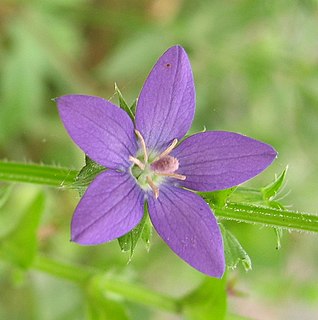
Triodanis perfoliata, the clasping Venus' looking-glass or clasping bellflower, is an annual flowering plant belonging to the family Campanulaceae. It is an annual herb native to North and South America, the natural range extending from Canada to Argentina. It is also naturalized in China, Korea and Australia.
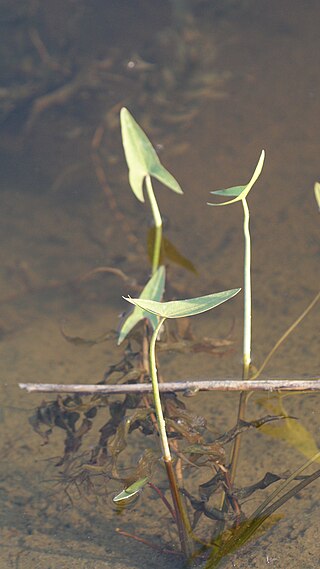
Sagittaria cuneata is a species of flowering plant in the water plantain family known by the common name arumleaf arrowhead or duck potato. Like some other Sagittaria species, it may be called wapato. It is native to much of North America, including most of Canada as well as the western and northeastern United States.
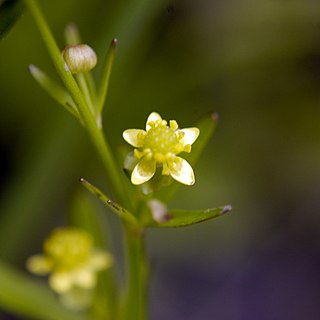
Ranunculus abortivus is a species of flowering plant in the buttercup family, Ranunculaceae. Its common names include littleleaf buttercup, small-flower crowfoot, small-flowered buttercup, and kidneyleaf buttercup. It is widespread across much of North America, found in all ten Canadian provinces as well as Yukon and the Northwest Territories, and most of the United States, except Hawaii, Oregon, California, and parts of the Southwest.
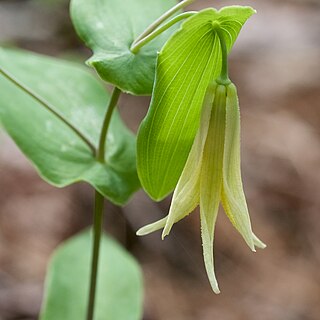
Uvularia perfoliata, the perfoliate bellwort, is a perennial forb native to the eastern United States and Canada, which produces pale yellow flowers in spring.

Solidago rigida, known by the common names stiff goldenrod and stiff-leaved goldenrod, is a North American plant species in the family Asteraceae. It has a widespread distribution in Canada and the United States, where it is found primarily east of the Rocky Mountains. It is typically found in open, dry areas associated with calcareous or sandy soil. Habitats include prairies, savannas, and glades.
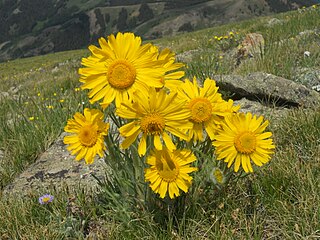
Hymenoxys grandiflora is a North American species of flowering plant in the daisy family known by the common names graylocks four-nerve daisy, graylocks rubberweed, or old man of the mountain. It is native to high elevations in the Rocky Mountains of the western United States.

Taenidia integerrima, the yellow pimpernel, is an herbaceous plant in the parsley family. It is native to the eastern North America, where it is widespread. Its natural habitat is rocky prairies and woodlands, often over calcareous substrates. It is a perennial.






















